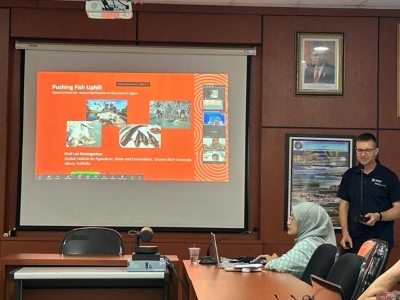Department of MSP IPB University Presents Fishway Expert from Australia for Aquatic Biodiversity Conservation in Dam Construction

Department of Aquatic Resources Management (MSP), Faculty of Fisheries and Marine Science (FPIK) IPB University organised a public lecture entitled 'The Importance of Fishway to Maintain Aquatic Biodiversity'. The activity presented Prof Lee Baumgartner, Executive Director of Gulbali Institute for Agriculture, Water and Environment, Charles Sturt University (CSU), New South Wales-Australia.
"Maintaining aquatic biodiversity is one of the competencies of the Department of MSP IPB University," said the Head of the Department of MSP IPB University, Prof Hefni Effendi. The lecture was one of the collaborative activities between MSP IPB University with CSU and the Research Centre for Marine Resource Conservation and Freshwater, National Research and Innovation Agency (BRIN).
Prof Lee delivered a lecture entitled 'Pushing Fish Uphill-Opportunities for Recovering Fisheries in the Oceania Region'. There were four parts to his presentation; the first related to 'All Fish Are Important and All Fish Migrate'. In this section, Prof Baumgartner drew participants' attention to the rich biodiversity of fish in Indonesia.
"There are approximately 1,000 species of freshwater fish in Indonesia. Some species require migration through rivers from upstream to downstream or vice versa to complete their life cycle," he said.
In the second part, he explained about 'River Development Can Impact Both Salt And Freshwater Fish'. He argued that the construction of irrigation weirs can disrupt the migration process of fish.
"These barriers to fish take the form of behavioural barriers caused by changes in various water environment conditions such as temperature, light, dissolved oxygen and chemical contaminants. Examples are the decline of fish in the Murray Darling River Basin-Australia, the decline of Chinook salmon in the USA and the decline of glass eels (eel larvae) in Indonesia," he explained.
The third section is entitled It is possible to reconstruct swimways, fishways are a solution. He emphasised that existing barriers do not have to be removed, but can be repaired.
"There are solutions to help fish migrate. The key is that we must study the entire life cycle of fish to build a fishway. Thus, every specification and type of fishway to be built must be in accordance with the target fish and river hydrology," he explained.
On the last part, Prof Lee delivered a presentation titled 'reinstating Fish Passage is not Quite Enough to Recover Fisheries'. According to him, the solution to improve fisheries needs to be integrated at the watershed level in order to improve fish biodiversity in the river.
Dr Arif Wibowo, Head of Research Centre for Marine Resources Conservation and Freshwater, BRIN added that with the issuance of Presidential Instruction No. 1 of 2023 on Mainstreaming Biodiversity Conservation in Sustainable Development. He believes that the instruction can strengthen the need for fishways to complement the infrastructure built in rivers.
The webinar was also attended by Dr Caroline Turner (Programme Manager Food and Agriculture Organization); Dr Chris Barlow (Adjunct Research Professor-CSU); PhD candidate Dwi Atminarso and Vitas Atmadi Prakoso, MS. The public lecture was hosted by Dr Majariana Krisanti and attended by hundreds of participants who attended both offline and online. Those who attended included master and doctoral students from the Aquatic Resource Management Study Programme, Coastal and Marine Resource Management Study Programme, Natural Resource and Environmental Management Study Programme and a number of practitioners from industry, government and non-governmental organisations. (MYK/AAY/Rz) (IAAS/RUM).


